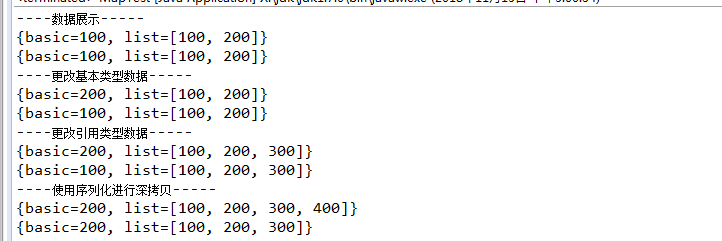Map的深浅拷贝的探究
1. 复制map示例
首先看一个例子,当我使用不同方法将一个源map拷贝到另一个map后,改变源map,复制后的map理应不受影响
import java.math.BigDecimal; import java.util.HashMap; import java.util.Iterator; import java.util.Map; import java.util.Map.Entry; public class MapTest { public static void main(String[] args) { Map<String, BigDecimal> detailsmap = new HashMap<String, BigDecimal>(); Map<String, BigDecimal> detailsmapByEquals = new HashMap<String, BigDecimal>(); Map<String, BigDecimal> detailsmapByPutAll = new HashMap<String, BigDecimal>(); Map<String, BigDecimal> detailsmapByIterator = new HashMap<String, BigDecimal>(); detailsmap.put("key1", new BigDecimal("123.22")); detailsmap.put("key2", new BigDecimal("156.2")); // 通过“=”的方式复制map对象 detailsmapByEquals = detailsmap; // 通过putAll的方式复制map对象 detailsmapByPutAll.putAll(detailsmap); // 通过iterator的方式复制map对象 mapCopy(detailsmapByIterator, detailsmap); System.out.println("detailsmap 的内容为:" + detailsmap); detailsmap.remove("key2"); System.out.println("移除key2的 detailsmap 的内容为:" + detailsmap); System.out.println("通过 “=” 复制的map当前值为:" + detailsmapByEquals); System.out.println("通过 “putAll方法” 复制的map当前值为:" + detailsmapByPutAll); System.out.println("通过 “iterator方法” 复制的map当前值为:" + detailsmapByIterator); } public static void mapCopy(Map detailsmapByIterator, Map detailsmap) { // 将detailsmap内容拷贝到detailsmapByIterator if (detailsmapByIterator == null) { detailsmapByIterator = new HashMap(); } if(detailsmap == null){ return; } Iterator it = detailsmap.entrySet().iterator(); while(it.hasNext()){ Map.Entry entry = (Entry) it.next(); Object key = entry.getKey(); detailsmapByIterator.put(key, detailsmap.get(key) != null?detailsmap.get(key):""); } } }
查看输出:

可以看到通过“=”复制的map内容随源map的改变而改变,而通过putAll方法和Iterator复制的map则不受源map改变的影响。
2. Map的两种拷贝类型
Map的拷贝分为两种情况:
- 浅拷贝:只拷贝对象的引用,两个引用仍然指向同一个对象,在内存中占用同一块内存。被拷贝对象的所有变量都含有与原来的对象相同的值,而所有的对其他对象的引用仍然指向原来的对象。即浅拷贝仅仅拷贝对象的引用,而不拷贝它所引用的对象。
- 深拷贝:被拷贝对象的所有变量都含有与原来的对象相同的值,除去那些引用其他对象的变量。那些引用其他对象的变量将指向被拷贝过的新对象,而不再是原有的那些被引用的对象。即深拷贝把要拷贝的对象所引用的对象都拷贝了一遍。
如示例中的三种拷贝方法:针对map中的数据为统一的、简单的基本数据类型,当拷贝的数据通过“=”复制map的方法为浅拷贝,putAll方法为深拷贝,iterator遍历添加的方式为深拷贝。
3. putAll方法并非深拷贝
两种深拷贝方法,iterator遍历添加的方式,由于是重新创建了一个对象,且遍历添加源Map的元素,因此在内存中另开辟了一块内存,毋庸置疑是深拷贝;而对于putAll方法参考其源码:
/** * Copies all of the mappings from the specified map to this map. * These mappings will replace any mappings that this map had for * any of the keys currently in the specified map. * * @param m mappings to be stored in this map * @throws NullPointerException if the specified map is null */ public void putAll(Map<? extends K, ? extends V> m) { int numKeysToBeAdded = m.size(); if (numKeysToBeAdded == 0) return; /* * Expand the map if the map if the number of mappings to be added * is greater than or equal to threshold. This is conservative; the * obvious condition is (m.size() + size) >= threshold, but this * condition could result in a map with twice the appropriate capacity, * if the keys to be added overlap with the keys already in this map. * By using the conservative calculation, we subject ourself * to at most one extra resize. */ if (numKeysToBeAdded > threshold) { int targetCapacity = (int)(numKeysToBeAdded / loadFactor + 1); if (targetCapacity > MAXIMUM_CAPACITY) targetCapacity = MAXIMUM_CAPACITY; int newCapacity = table.length; while (newCapacity < targetCapacity) newCapacity <<= 1; if (newCapacity > table.length) resize(newCapacity); } for (Map.Entry<? extends K, ? extends V> e : m.entrySet()) put(e.getKey(), e.getValue()); }
通过源码可以看到putAll() 方法的实现仅仅是将源Map的第一层put进Map中,这种方式对于value为基本类型的map复制是实现深拷贝的效果的,但是当value为对象时,是不会奏效的。这里简单使用源Map内嵌Map的方式测试putAll方法,看其是否实现了深层次的复制:
import java.util.HashMap; import java.util.Map; public class MapDeepCopy { @SuppressWarnings("unchecked") public static void main(String[] args) { Map<String, Object> map = new HashMap<String, Object>(); Map<String, Object> mapCopy = new HashMap<String, Object>(); // Map中要嵌套Map Map mapInner = new HashMap(); mapInner.put("num", "100"); map.put("key1", mapInner); map.put("key2", "600"); // 复制 mapCopy.putAll(map); System.out.println("使用“putAll”方法复制map到mapCopy中,此时mapCopy值为:————"+mapCopy); // 更改复制之后的map中内嵌map的内容 ((Map) mapCopy.get("key1")).put("num", "200"); System.out.println("更改复制之后的mapCopy内容,更改之后mapCopy值为:————"+mapCopy); System.out.println("此时源map map的值为:————"+map);// 源Map也被改变 } }
输出如下,说明map和mapCopy中的mapInner元素使用的还是同一块内存:

4. Map深拷贝的实现
有一种方法,是使用序列化的方式来实现对象的深拷贝,但是前提是,对象必须是实现了Serializable接口才可以,Map本身没有实现 Serializable 这个接口,所以这种方式不能序列化Map,也就是不能深拷贝Map。但是HashMap是可以的,因为它实现了 Serializable。下面的方式,基于HashMap来讲,非Map的拷贝。
/** * @Title: 对象深度克隆---使用序列化进行深拷贝 * @Description: 使用序列化的方式来实现对象的深拷贝,但是前提是,对象必须是实现了 Serializable接口才可以,Map本身没有实现 Serializable 这个接口,所以这种方式不能序列化Map,也就是不能深拷贝Map。但是HashMap是可以的,因为它 实现了Serializable。 * @param obj * @return T */ @SuppressWarnings("unchecked") public static <T extends Serializable> T clone(T obj) { T clonedObj = null; try { ByteArrayOutputStream baos = new ByteArrayOutputStream(); ObjectOutputStream oos = new ObjectOutputStream(baos); oos.writeObject(obj); oos.close(); ByteArrayInputStream bais = new ByteArrayInputStream( baos.toByteArray()); ObjectInputStream ois = new ObjectInputStream(bais); clonedObj = (T) ois.readObject(); ois.close(); } catch (Exception e) { e.printStackTrace(); } return clonedObj; }
调用
import java.io.ByteArrayInputStream; import java.io.ByteArrayOutputStream; import java.io.ObjectInputStream; import java.io.ObjectOutputStream; import java.io.Serializable; import java.util.ArrayList; import java.util.HashMap; import java.util.List; public class MapTest { public static void main(String[] args) { List<Integer> list = new ArrayList<Integer>(); list.add(100); list.add(200); HashMap<String, Object> map = new HashMap<String, Object>(); // 放基本类型数据 map.put("basic", 100); // 放对象 map.put("list", list); HashMap<String, Object> mapNew = new HashMap<String, Object>(); mapNew.putAll(map); System.out.println("----数据展示-----"); System.out.println(map); System.out.println(mapNew); System.out.println("----更改基本类型数据-----"); map.put("basic", 200); System.out.println(map); System.out.println(mapNew); System.out.println("----更改引用类型数据-----"); list.add(300); System.out.println(map); System.out.println(mapNew); System.out.println("----使用序列化进行深拷贝-----"); mapNew = clone(map); list.add(400); System.out.println(map); System.out.println(mapNew); } }
输出如下:

附:
【4. Map深拷贝的实现】转自:https://www.cnblogs.com/cxxjohnson/p/6258742.html


 浙公网安备 33010602011771号
浙公网安备 33010602011771号